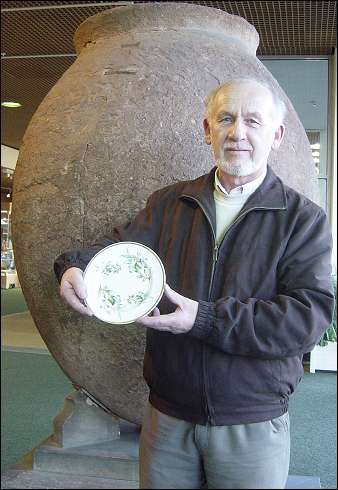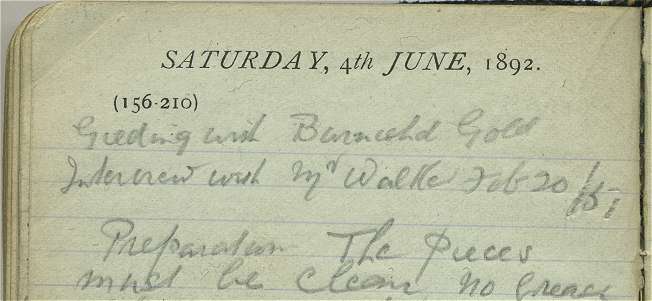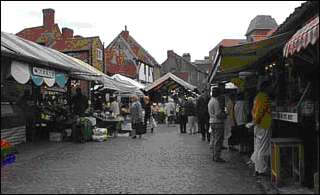|

Mr. Peter Ferneyhough
|
This is our first donor, Peter
Ferneyhough, in the entrance to
the Potteries Museum and Art
Gallery in Stoke on Trent.
He is holding a plate decorated
at Longton Hall Works, founded
in 1873 by his great-grandfather
James Ferneyhough |
The Ferneyhough family history
The
Longton Hall
Works was founded in 1873 by our donor
Peter’s great-grandfather James Ferneyhough.
The company decorated and sold blank ware
which was produced by other pottery
manufacturers.
James
Ferneyhough
had two sons,
Leonard
and Thomas. Leonard went into the business,
but Thomas refused. Leonard eventually ran
the works and handed it on to his son
Wilfred.
Nothing was made at the site - the factory
bought in ready-made tableware (plates,
cups, saucers and so on) painted decorative
designs onto them, and fired them in a
bottle oven.
Wilfred’s notes on
gilding with burnished gold,
recorded in a notebook, calculate the cost
and the likely profit from this
production.......
|

This account can be
found in the diary which
Wilfred used as a
notebook:
Interview with Mr
Walker, Feb 20/51
Preparation: The pieces
must be clean, no grease
or foreign matter
Ord Lithos can be gilt
with one face
Do finish Litho Deco
only
Clean with methylated
spirits not Turps If
Turps is used
application of cold
clear water to clean &
thoroughly dried
No blobs of gold must be
allowed to go on the
ware as it will peel off
A reasonable ‘coat’ of
gold will do.
Bottle must be
thoroughly shaken up &
down to fetch up the
gold sediment
|
Wilfred
Ferneyhough (grandson of the founder)
had two
sisters, Marion and Lorna. Marion worked as
a secretary for a number of potteries in
Stoke. She died in 2000 at the age of 90.
Her sister Lorna, worked as a free hand
paintress, first at the Longton Works, and
later at Wedgwood.
Most of the tableware
produced at Longton Hall Works was sold in
markets in Lancashire
- Haslingden, Rawtenstall and Rossendale for
example. The material was delivered to stall
holders in the
works’ van.
Wilfred’s notebook gives us a
list of things he never need buy
- presumably as he was able to acquire all
he needed from market traders.
|

Markets in Lancashire
There were stalls in Bacup,
Rawtenstall, Rossendale
and Haslingden, and may have
been more.
Most of the ware produced at
Ferneyhough’s Longton Hall Works
was sold in markets in
Lancashire, where they traded as
Calgrove Pottery Stores.
Accounts produced in 1925 show
that the annual cost of fuel,
carting, crates and straw
exceeded that of raw materials
bought to decorate the plates.
In 1942 the cost of market tolls
exceeds that of materials, and
by 1950 (the year in which we
see Wilfred’s despairing
memorandum) the entry for
‘Stalls, Rents and Market
Expenses’ is £121/2/3. Only
buying in the ware for
decoration and wages were larger
business expenses.
|
Wilfred’s
advice on
setting out a stall
with goods (to Mrs Hickson, a vendor in
Bacup, Lancs.) is recorded in his diary. In
1960 the site in California Street,
Longton, where the Works stood, was taken
over by Stoke City Council. A
letter
from the Estate Valuer’s Department states
the purchase price was £1,100.
Wilfred’s son
Peter - shown above, believes the factory’s
compulsory purchase may have been a relief
to his father. In school holidays Peter
would work loading the bottle oven with ware
for firing, but holiday jobs aside, Wilfred
actively discouraged his son from going into
the industry. When the business was sold,
Wilfred joined the Creda Works of the
Simplex Electric Company in Blythe Bridge, a
village just outside Stoke. Peter went on to
work in the chemical industry at James Brown
Ltd, manufacturers of zinc oxide. (There is
a connection with the family history of
paint though - zinc oxide is a principal
element in the colour battleship grey - used
by the navy for their warships.) |